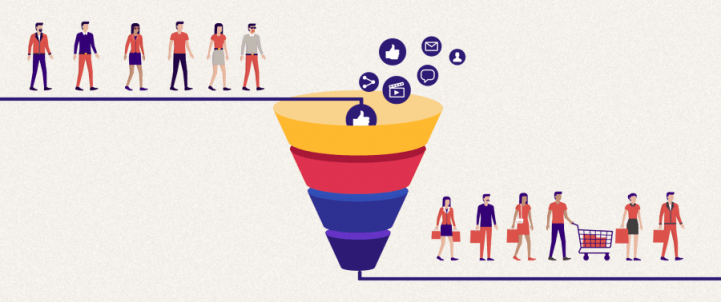“Where in the onboarding process are we losing the most users?”
“Which channels are our power users coming from?”
“Where can we invest more marketing budget, and where should we scale back?”
If you’re digging through a giant mess of user data trying to find real answers to questions like these, good luck to you. Where do you begin?
You can’t just guess — even if it’s an educated guess.
Luckily, you don’t have to. You can use funnel analysis to know for sure.
What Is Funnel Analysis?
Conversion funnel analysis helps you understand exactly how people are interacting with your app. It visualizes the user journey to show you how many people convert and where they drop off.
Use funnels to discover friction points and zero in on areas that will have the greatest impact on growth.
Funnels are like the speedometer in your car, telling you how fast you’re going and whether you’re slowing down or speeding up. And they tell you when to take action: where should you press the brakes — or the accelerator?
Funnel Analysis Example
Let’s say we have an ecommerce mobile app with 50,000 users.
As Michael Taylor explains, we can start by breaking this user base down into type: new users, returning users, and converted customers.
Now we have a basic funnel — one that clearly shows we have a retention problem.
Only 20% of our users come back to the app a second time, and only 10% ever make a purchase.
From here, we might focus on creating behavioral cohorts to get to the bottom of the retention issue and entice more users to stick around.
But say our funnel looks more like this: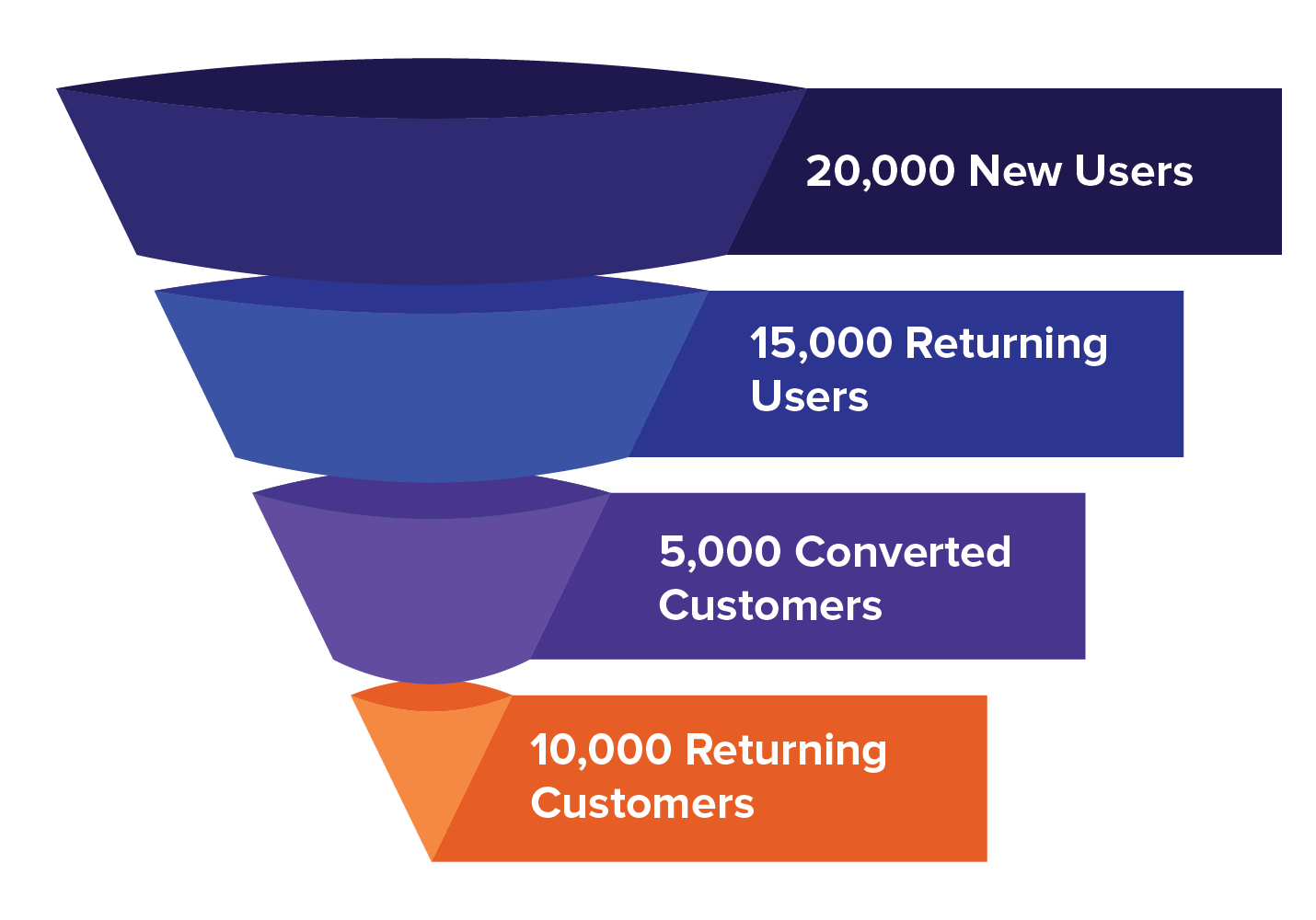
Not only are we doing much better at retaining and converting users, 2 out of 3 customers go on to purchase from us again.
Knowing this, we can put more resources into enticing users to complete their first purchase, possibly by offering a discount or free shipping, since they’re very likely to come back and buy again.
Conversion Funnel Analysis: Referral Attribution
Another way to use funnels?
To see which channels are bringing in the most customers.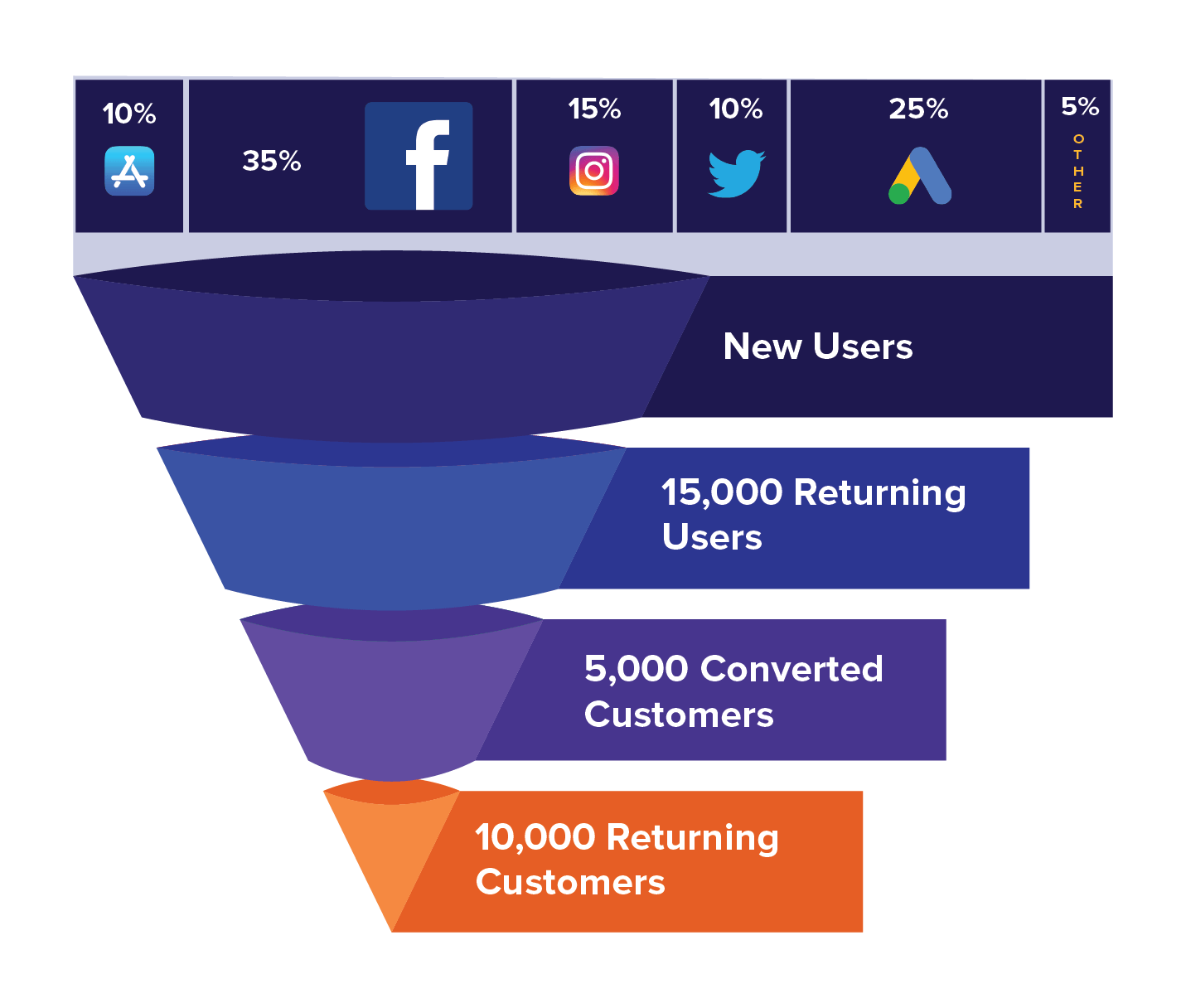
Facebook and Google Ads are performing the best when it comes to new users.
But what if these new users aren’t coming back, or converting?
We can look further down the funnel to see where most of our paying customers are coming from.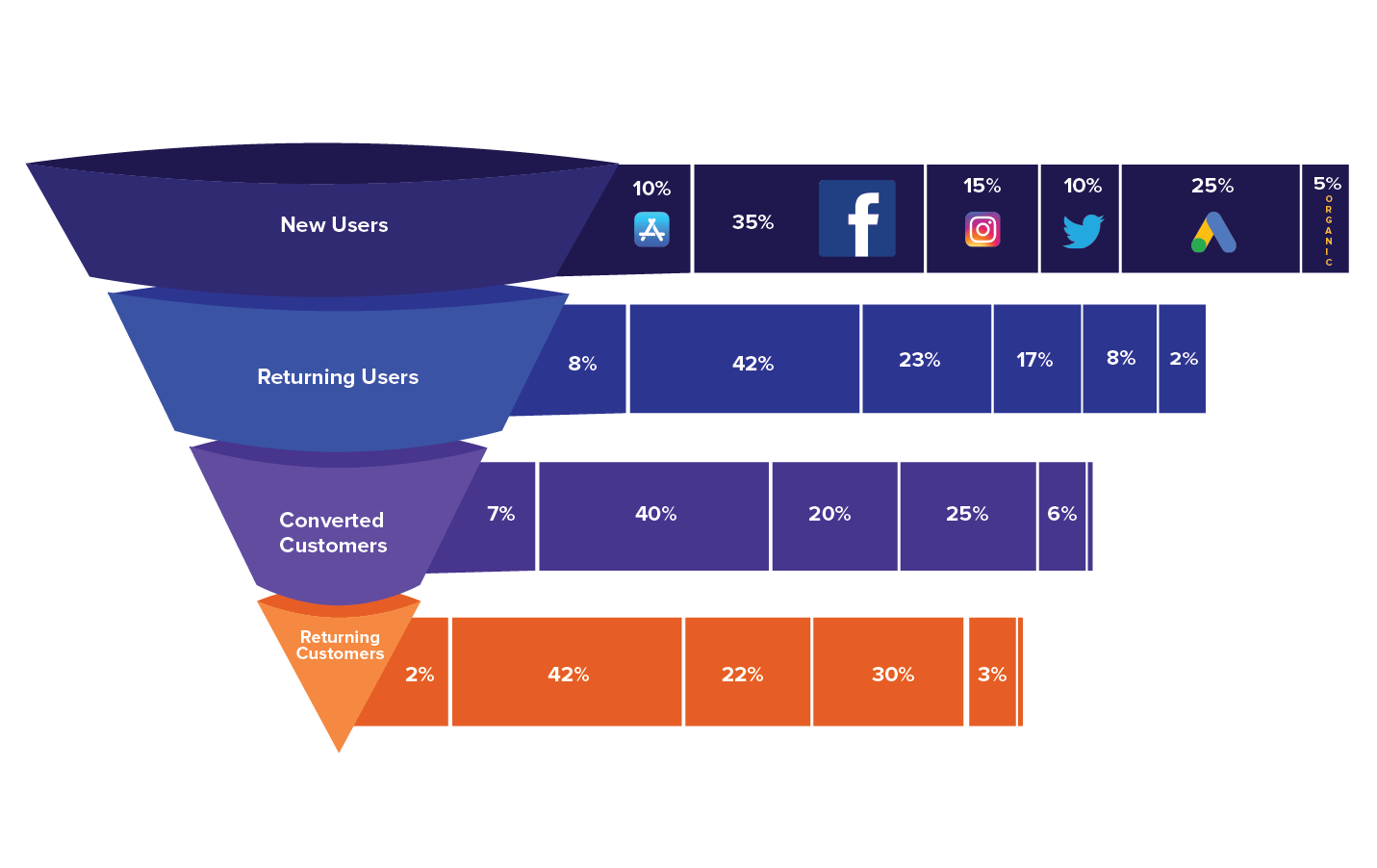
Facebook accounts for 40% of our paying customers, but new users acquired via Instagram are converting at a higher rate.
Google Ads campaigns get us 25% of our new users, but only 6% of them become paying customers.
It’s pretty clear we should ramp up efforts on Instagram and decrease our Google Ads spend.
Conversion Funnel Analytics: Measure Monthly
It’s also important to track your performance over time. By comparing funnels for each month, we can see whether we’re growing… or dying.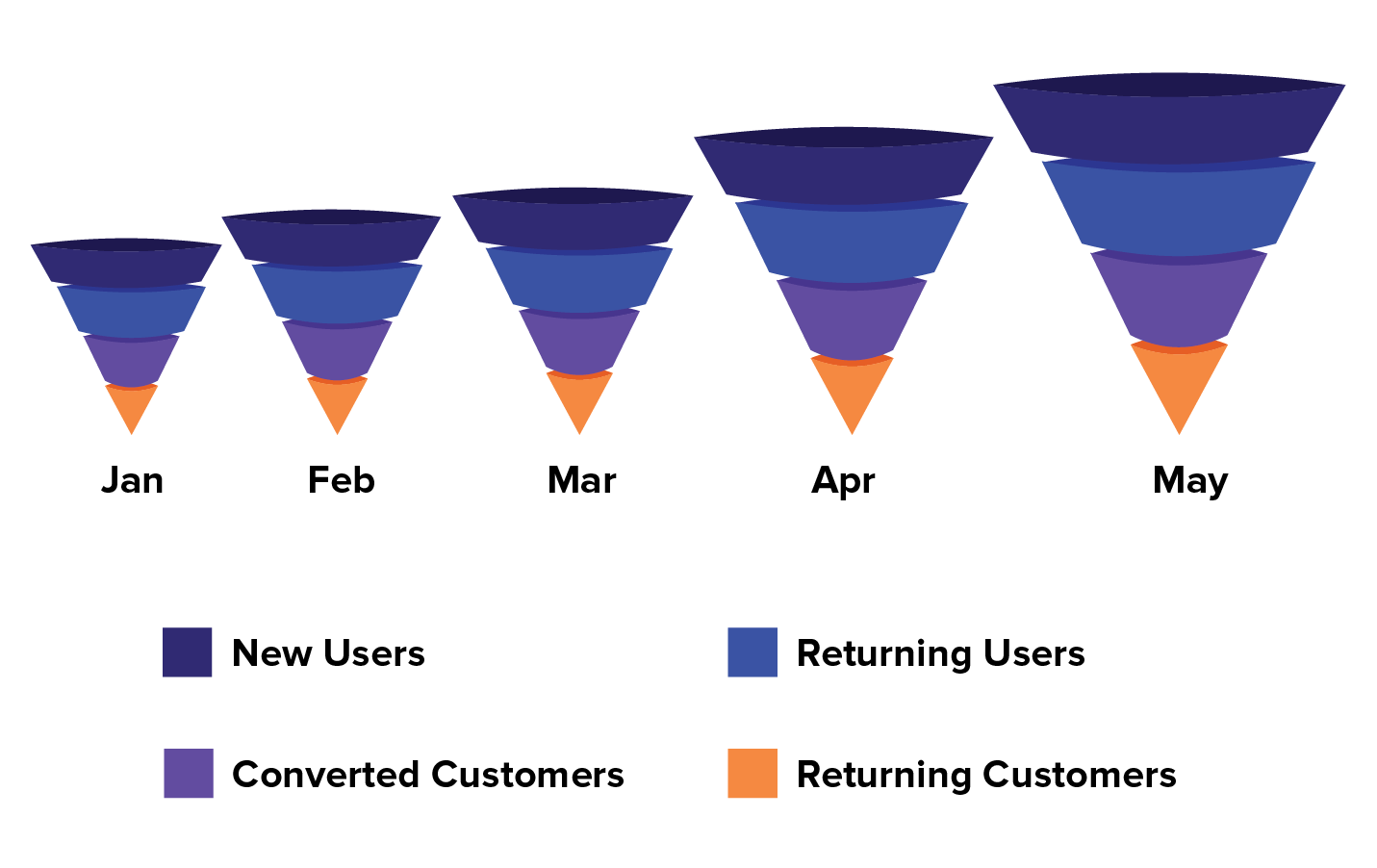
By comparing monthly funnels, we can see that we’re both improving retention of returning users, and converting more of them into paying customers.
We’ve proven that we can retain and convert at the bottom of the funnel.
It’s time to ramp up marketing efforts to add new users at the top of the funnel — and start growing our app exponentially.
Funnel Analysis Introduction
Before you jump in and go crazy with the bar charts, it’s important to set some goals for your particular app.
What types of conversions are important for your business?
What do users want when they come to your app?
Step 1. Define the metrics that are most important for your business.
For ecommerce apps, it’s transactions.
For social media apps, it’s sign ups and daily active users (which means better advertising opportunities).
For health and fitness apps, it could be weekly active users, subscriptions, or in-app purchases.
Which metrics are essential to your app’s success?
These are the conversions you should build your funnels around.
Step 2. Identify the key touch points that lead to conversions.
What goals do users have when they come to your app, and how might they navigate the app to achieve those goals?
User journeys aren’t always linear.
Some retail app users might browse new product pages, while others search for a specific item or item type.
Some media app users may create an account during the onboarding process. Others may opt out, browse in-app content, and return to create an account after several sessions.
Think about all the ways users could get to the point of conversion.
Here are a few marketing funnel analysis examples to get you started: 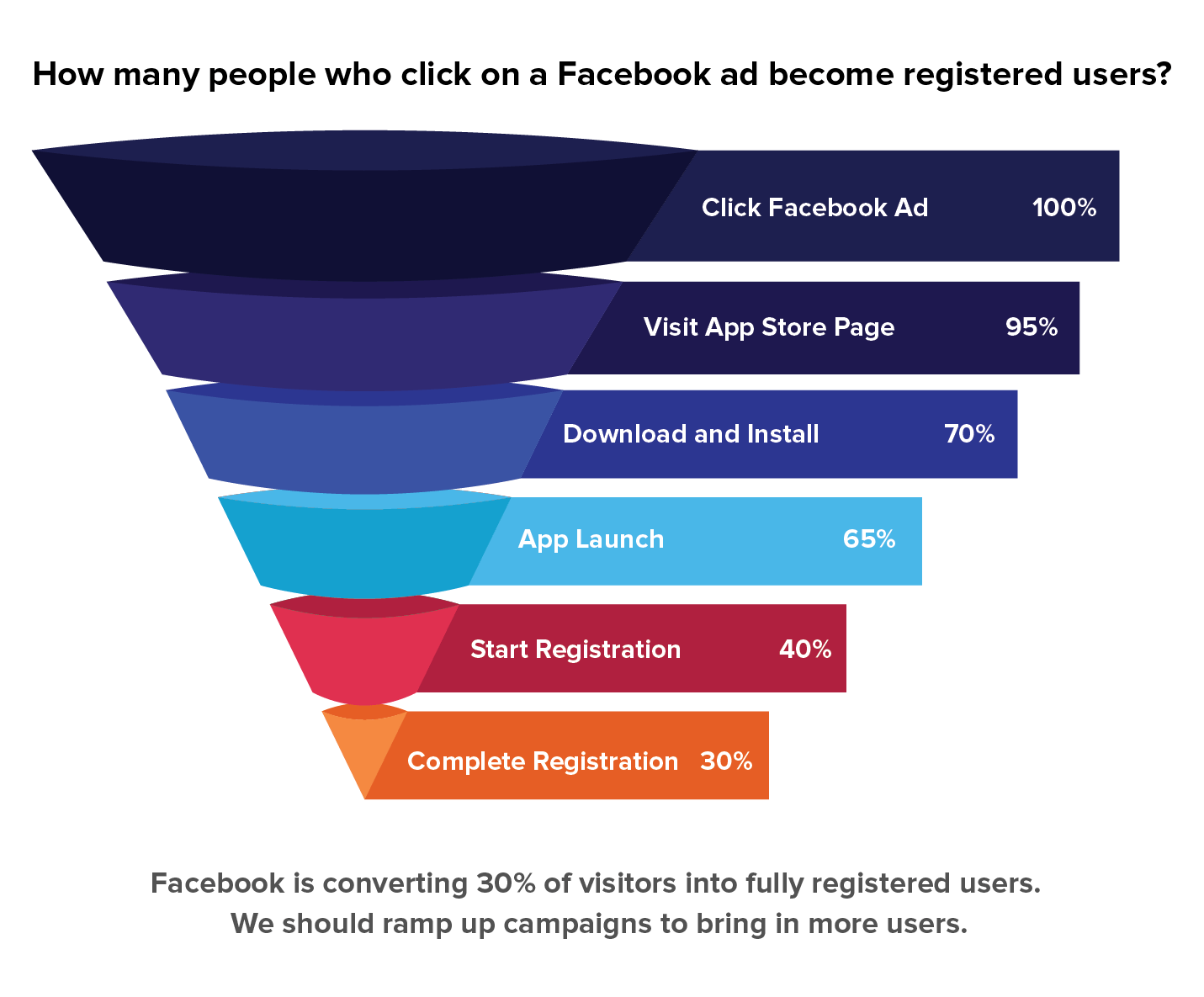
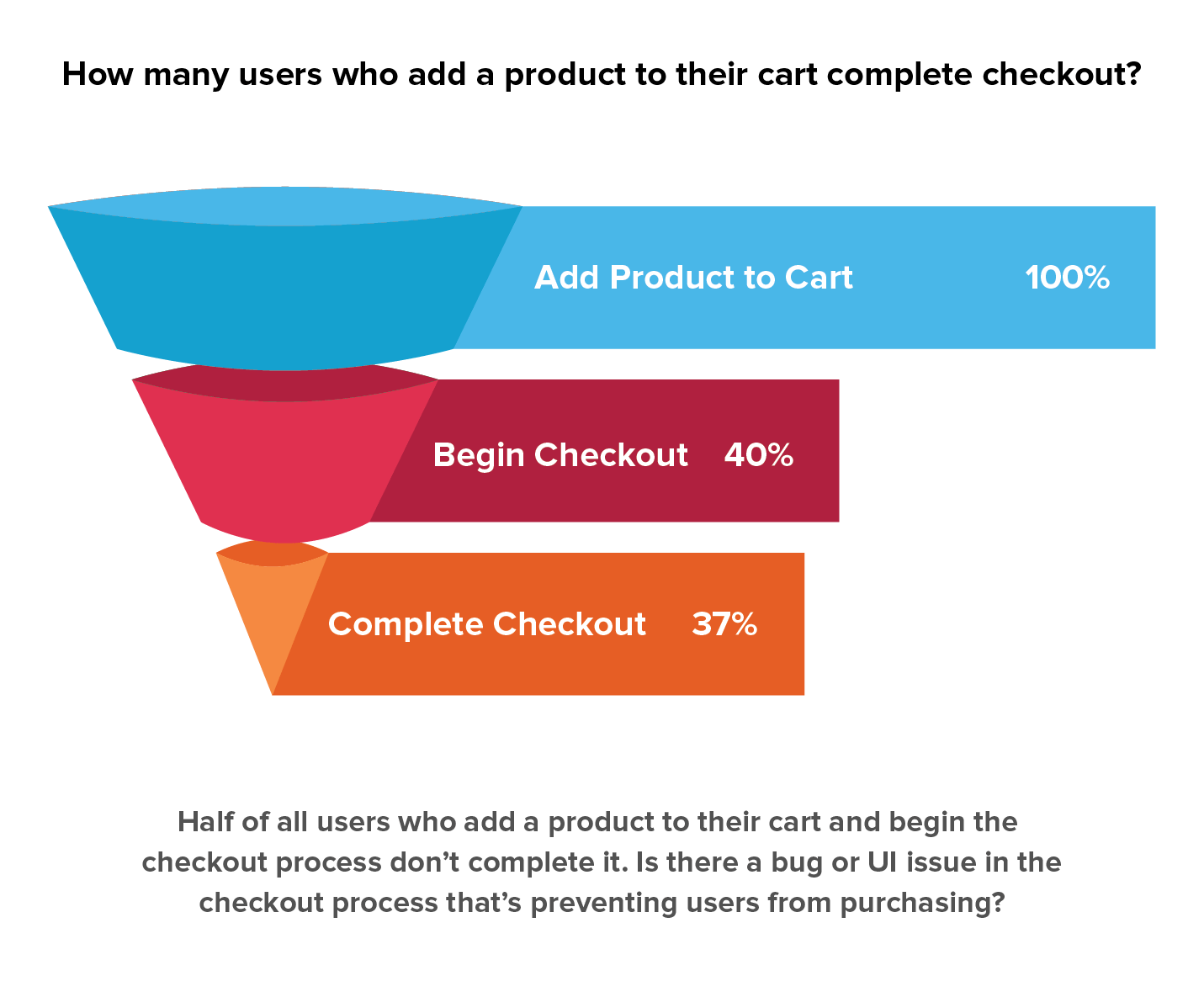

Step 3: Get deeper insights by segmenting users and comparing funnels.
Not all users are equal — not even users who convert.
Do users in the US follow different paths to conversion than users in Asia? Do female users convert faster than male users? Do users who follow a particular user journey convert at higher rates?
Maybe users age 30+ take longer to convert but are more likely to become repeat customers or have a much higher order value, while younger customers convert quickly but don’t spend as much and churn at a higher rate.
This type of information is critical for informing your growth strategy.
Conversion Funnel Analysis: Deep Dive
Once you’ve mastered the basics of funnel analysis, you can consider things like funnel types and conversion windows to get more precise details about user behavior.
Strict vs. Loose Funnels
When setting up your funnels, consider whether you want to use strict or loose funnels.*
Strict funnels measure users who follow an exact path. Loose funnels allow users to complete other actions between funnel steps, as long as they complete the steps in order.
When should you use strict or loose funnels?
Well, it depends on what you’re measuring.
The checkout and payment process, for instance, would require a strict funnel. Users have to follow that process exactly in order.
Most other actions, like selecting and booking a hotel in a travel app, are better modeled using a flexible funnel.
Why?
If you require what turns out to be an unnecessary step, you could miss out on data from users who enter your funnel but bypass that step.* This will skew your drop off rates, leading to misleading insights — and misguided business decisions.
Setting Conversion Windows
Measuring how long it takes users to move through your funnel can give you important information about opportunities for in-app messaging, remarketing campaigns, or UI fixes that can boost conversions.
How do you know how long to set your conversion window for?
To start, you can use historical data: how long is it currently taking your users to move through each step of the funnel?
You should also consider the nature of the funnel you’re measuring.
Some funnels will naturally take more time: a funnel with several steps may take multiple sessions or days to complete. Shorter funnels, like the onboarding process, should ideally be completed in a single session.
The checkout process, for instance, should move users through pretty quickly. If time between steps is unusually long, there could be an issue with submitting payment or delivery information that’s slowing users down, causing frustration and drop-offs.
In a travel booking app, funnel stages can represent users browsing different destinations and vendors. For these funnels, it would naturally take longer to move from one step to the next.
Identifying which steps take more time can present an opportunity for personalized marketing.
A push message notifying a drop in airfare, or an email listing top-rated restaurants and attractions in the user’s destination of interest, can nudge them towards a purchase.
Fixing Dropoffs
Once you’ve identified trouble spots in your funnel, how do you know what to fix?
Think like a user. (Or better yet, ask real ones!)
Launch your app and pretend you know nothing about it. Move through the funnel yourself.
What annoys you or slows you down?
An overly long registration process, bugs in the UI, confusing instructions, too many links — even seemingly small issues can have a big impact on user experience.
Remove all distractions at critical points in your funnel, and make the desired action easy to take.
Then ask yourself:
What are users who didn’t convert doing instead? How can you use that information to improve your funnel?
Say users of a social media app are leaving the registration process to view other profiles before completing their own. You could show a sample profile during the registration process.
If they’re leaving to use the search function to find friends already on the site,show them users they know early on in the registration process, or add a list of suggested friends.
Unlock higher retention today! Get started with CleverTap.
Funnel Analysis for Improving Conversion Rate
User funnel analysis shows you where people are dropping off, but not why.
Here’s how to find out and improve your conversion rates. Look at:
Bottlenecks
Is there a big drop off in an unexpected place?
You’re always going to see users drop out during the step where they enter their credit card details. But if you’re seeing a big drop in the step where users enter their shipping info, there could be a problem.
Maybe the format for entering their phone number or address is confusing or buggy, preventing them from moving on to the next step.
Time-bound Trends
Is there a certain time of day that users are most active on your app? Or a window where the majority of your users make a purchase? How long does it take a user viewing product pages to add an item to their cart? How long from there to complete a purchase?
This can tell you a lot about how effective your in-app communication is.
Of course, it will naturally take people longer to make a purchase decision on a $2,000 handbag than a $20 t-shirt. But by providing the right information in the product description, pictures, and ratings/reviews, you can help users make a decision faster — and have a good experience with your app.
User Segments
Finding user segments that are more successful at certain steps gives you important insights about who to target in the future — and why other users got stuck.
Use cohort analysis to dig deeper into the reasons users aren’t converting.
Are they all on an older version of the app that’s crashing? How long have they been using the app? What about users who do convert — do they search for products rather than browse? Do they rate or review products?
Run tests against segments to optimize your conversion funnels.
For instance, say you’re focusing on upsell opportunities. If someone adds an item to their cart, your app suggests related products to add.
But doing so also creates some friction, and some users are abandoning their carts. By running tests against segments, you might see that most of the people abandoning are first-time buyers, and exclude them from upsells.
4 Funnel Analysis Errors to Avoid
Analyzing funnels may seem pretty straightforward, but it can be easy to look at a funnel and jump to the wrong conclusion.
Watch out for these common assumptions that can quickly lead to major missteps.
1. Your focus should always be on high drop-off points.
If the biggest drop off is between the top and middle of the funnel, you might be tempted to start there. But it won’t do your business any good to fix that hole if you’re only going to lose them at the bottom of the funnel anyway.
Get the users you have to convert and retain at a higher rate, and then ramp up marketing to add more users.
Plus, high drop-offs are often the hardest to improve. It’s usually easier to fix smaller friction points for incremental gains (which still have a significant impact on conversion rates) than to go after big drops right away.*
2. High drop off means there’s something wrong with the user experience.
It’s easy to see a high drop off and immediately assume there’s something wrong with your app — a bad bug or serious UI issue.
But stop and think: are you attracting the right type of user to your app to begin with? Look at who you’re targeting (and how) to make sure you’re driving the right users to your app.
3. Funnels end at the point of conversion
User retention is essential to your app’s growth. You should always be thinking of what users experience immediately after they convert.
What can you do to encourage converted users to keep coming back? How can you plant the seeds that will make your app part of their daily routines?
4. All users should follow the same conversion path
Consider flipping the funnel.
One way to eliminate the friction that keeps new users from immediately discovering your app’s core value? Let them experience it before asking them to sign up.
Consider Airbnb: users can browse listings and add dates, and are only asked to sign up when they’re ready to book.
Why Funnel Analysis is the Key to Growing Your Mobile App
Funnels aren’t just about measuring conversion rates.They’re about uncovering what users ultimately want from your app, and where you need to deliver it.
Mine your data to compare funnels by date range, acquisition channel, and user attribute.
For funnels to be meaningful, you need to look at them in the context of user behavior. Pay attention to where both converted and lost users are going.
If you can pinpoint the root cause, finding a solution gets that much easier.
Whether you’re tracking onboarding and purchase processes or re-engaging lost users, funnels are a powerful tool to improve conversions and measure the specific goals that are essential to your app’s success.
Want to know more about funnels?
Shivkumar M 
Head Product Launches, Adoption, & Evangelism.Expert in cross channel marketing strategies & platforms.
Free Customer Engagement Guides
Join our newsletter for actionable tips and proven strategies to grow your business and engage your customers.















































